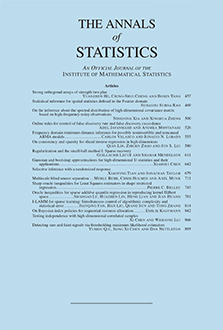Abstract
It is shown that, for kernel-based classification with univariate distributions and two populations, optimal bandwidth choice has a dichotomous character. If the two densities cross at just one point, where their curvatures have the same signs, then minimum Bayes risk is achieved using bandwidths which are an order of magnitude larger than those which minimize pointwise estimation error. On the other hand, if the curvature signs are different, or if there are multiple crossing points, then bandwidths of conventional size are generally appropriate. The range of different modes of behavior is narrower in multivariate settings. There, the optimal size of bandwidth is generally the same as that which is appropriate for pointwise density estimation. These properties motivate empirical rules for bandwidth choice.
Citation
Peter Hall. Kee-Hoon Kang. "Bandwidth choice for nonparametric classification." Ann. Statist. 33 (1) 284 - 306, February 2005. https://doi.org/10.1214/009053604000000959
Information





